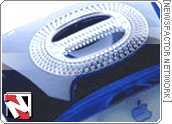Computers as a Fashion Statement, Part I: The
iMac and its Legacy
11/10/00
By
Stanislav Kelman

What is it that so distinguishes the iMac from the rest
of the flock?
 |
Ever since the
initial release of the first iMac, there hasn't been
another computer whose merits were so actively debated. Even two and
a half years later, it continuously inspires people to write
editorials, such as this one. There is just something about
the iMac that draws a lot more attention to it than to the countless
models released by all the other top-tier computer manufacturers
combined.
Now,
before you start bashing me for being an Apple fanatic, I would like
to provide some statistics to back up the above statement. And, in
fact, I won't even have to go looking for data any further than this
very site. Doing a simple search
for the word "iMac" right here on osOpinion, returns as many as 249
relevant Web pages. This is more that the 235 entries that you get
when looking for any term in the "Compaq, HP, Hewlett,
Packard, Dell, Gateway, eMachines" search string. What is even more
impressive is that a query for "Apple Macintosh" returns 666
documents, which means that more than one third of the site's
contributors were compelled to mention the "evil" machine.
So,
what is that something that makes such a huge difference
between the iMac and the rest of the flock? I dare to claim that the
clue lies in nothing else but the Genuine Sense of Style.
Incidentally, this is exactly what John Dvorak, a long-time ZDNet
columnist, was pointing out in his recent column entitled "Time to
Defend Apple."
Arguably, the nearly pathological lack of taste among geeks
is the main reason why replicating the success of "the little
computer that could" proved to be so difficult. For people who think
of a freebee T-shirt as an ultimate fashion statement, there is
nothing more difficult than trying to grasp the bizarre notion of
Style. Thanks to them, the iMac copycats, such as Gateway Astro and eMachines eOne, were brought
into this world only to vanish quickly and without a trace.
It got
so bad that I was starting to suspect that multi-billion companies
like Dell still might not
have a single professional designer on staff, or else they wouldn't
be using the same bland beige boxes for decades. Up to now, the
employees of these "high tech" establishments never had much of a
reason to be interested in industrial design, or fine art, or
anything else that could not be easily quantified with a performance
benchmark. But then again, even Dell finally gave into the craze and
came up with the new OptiPlex
chassis design. Give these guys a few more years and they might even
discover the wonderful world of colors beyond the 8 shades of gray!
In any
event, while others were playing catch-up, the influence of the iMac
on technology in general has been remarkable indeed. Even on the
surface, the abundance of translucent products on the shelves of
your local electronics store will convince you that it has had
effects far beyond the Mac user community, or even the computer
industry as a whole. Thanks to Apple, even the traditionally
design-agnostic Windows users are starting to realize that the
experience of using a computer has next to nothing to do with
all those hyped-up technical specs.
However, one thing that became even more painfully obvious
than ever is that the herd mentality, that has defined the PC
industry for decades, is alive and well. Somehow, the clueless
marketing folks all around the globe were fooled into believing that
translucent casing is some kind of a magic bullet. The truth of the
matter is that the secret to the iMac's success is not just in its
colored plastic, but in its general appeal to both the wallet and
the senses. What these guys fail to realize is that when you slap a "Barbie"
logo onto a cheap generic computer ... you still get a cheap
generic computer.
Of
course, there are exceptions to every rule, and one of them is Handspring, a company
founded by the same people who brought us the original PalmPilot.
Although Handspring's awesome gadgets do feature translucent cases,
they also offer expansion options beyond those available for regular
Palm
organizers. Once again, the key here is attractive design, coupled
with value-added features, available for a reasonable amount of
money.
But
whenever I start talking about good-looking exterior designs, the G4 Cube
immediately comes to mind. So, please check back next week for a
discussion of the influence of the Cube on the direction in which
the computer industry might be heading...

Author's background:
Stanislav
Kelman doesn't own an
iMac but "administers" his roommate's original bondi blue
machine. And, although he has a couple of his own computers (a Mac
and a PC), he still likes playing around with the iMac whenever he
gets a chance. He even openly admits that, for reasons beyond his
own comprehension, using either one of his beige boxes never
seems to come even close to providing the sheer enjoyment of
day-to-day computing on the iMac. Stanislav would love to hear your
reaction to his opinion columns, so feel free to drop him a line at
osOpinion@LetItBe.org.
|



